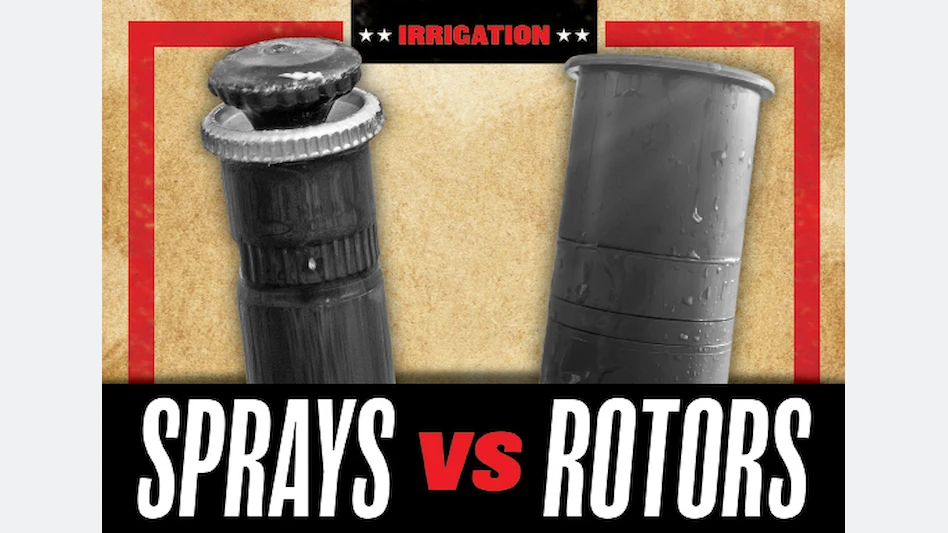
While each job site will present its own unique challenges, there are some universal qualities that make either spray heads or rotor heads the advantageous choice in certain locations and conditions.
“The fundamentals and the principles behind the design are still the same as they were when I took design classes years ago. The products are addressing all of that. Most of the changes over the years have been with the control systems and some of the heads,” says Pete Diebolt, president of Diebolt Landscape in Mohnton, Pennsylvania.
The system design accounts for environmental conditions like wind or shade, elevation changes, the square footage of the area to be watered, and more. From there, choosing between a rotor head and a spray head comes down to a few other factors.
“The type of head that you use is dictated by the design because the heads are going to have all different lengths of throw and uniformity coefficient. The distribution pattern, wind, slope
Rotor heads:
The pros. Generally, rotor heads are the better choice for larger areas of turf. They have a low precipitation rate, so they will evenly cover more area over a longer period of time. This is ideal for sloped areas because it allows more time for water absorption. The head itself will also be larger and provide more coverage than a spray head,
“The coverage might be three or four times the square footage. Labor savings is incredible,” he says.
Rotor heads also tend to require less maintenance than spray heads. Most rotors nowadays will pass the majority of debris found in reclaimed water sources without clogging,
The cons. However, rotor installation may take a little longer than spray heads because their ultimate positioning is not immediately evident, says Justin Moseley, irrigation manager for Nelson Landscaping [JM1] [BH2] in Edmond, Oklahoma.
“You have to set them and then recheck them after they are installed, whereas with pop-up sprays, once I flush them out, I can set a nozzle and know which way it’s going to spray. Be it a fixed or adjustable nozzle, I can set it where I don’t even have to have water running through it to be set whereas rotors need a little more fine-tuning,” Moseley says.
Rotors can also be a little more expensive to install. They are spaced further apart, so the material cost can be a little more than what a spray head would be,
“Your primary decision is based on
Spray Heads:
The pros. Spray heads are designed for smaller areas and disperse more water in a shorter amount of time. This makes them a good choice for areas close to buildings, patios or other hardscaping on site that is not intended to get wet.
“For flower beds, we use nothing but pop-up spray heads. If it’s a smaller area, from 8-20 feet, we are doing spray heads,” Moseley says.
“In Oklahoma, we have hard water that causes calcium deposits to build up in the nozzles. About every five years depending on water quality, you’ll have to replace the internal filter on that nozzle. Rotors don’t have that filter, so they are flushing all of that hard water buildup out,” he says.
Compromises. With either type of sprinkler head, there are
Rotary nozzles used on a spray head also provide a versatile solution for mid-size areas. The nozzle Diebolt prefers is made in both male and female for use on any spray head.
“Instead of a thick spray that just sits there static when the head pops up, (the) product actually has a gear-driven rotor inside the nozzle body that acts
The biggest challenge in taking advantage of all the bells and whistles can be educating the customer on their benefits, Moseley says.
“The cost difference between them is significant, so it is important to educate the customer on why you are going with triple the amount for one head versus the other,” he says. “In the consultation, we explain how a 4-inch popup is going to be blocked by all of the shrubs here, so that’s why we want to have the 6-inch and the 12-inch so we get overlapping coverage for the flower beds.”
Contractors should also prioritize creating efficient system designs and getting the proper training to achieve it. All sprinkler heads are adjustable to a certain extent without affecting the spray pattern, but above all, the design is about distribution uniformity. Systems should be as operable in the driest, hottest time of the year as they are in wet periods,
“Some of the heads are helping with that because they are forgiving and cover up the sins of the lesser-trained folks out there in the industry,”
Latest from Lawn & Landscape
- Landscape Workshop acquires Cut Above Enterprises
- Scythe debuts new generation of M.52
- New identities
- Ruppert promotes Anderson to director of talent acquisition
- Fleet on the Street
- Man in the mirror
- EverSmith Brands appoints Ken Hutcheson as its new CEO
- Manitou unveils new Woodcracker tree saw with grapple





